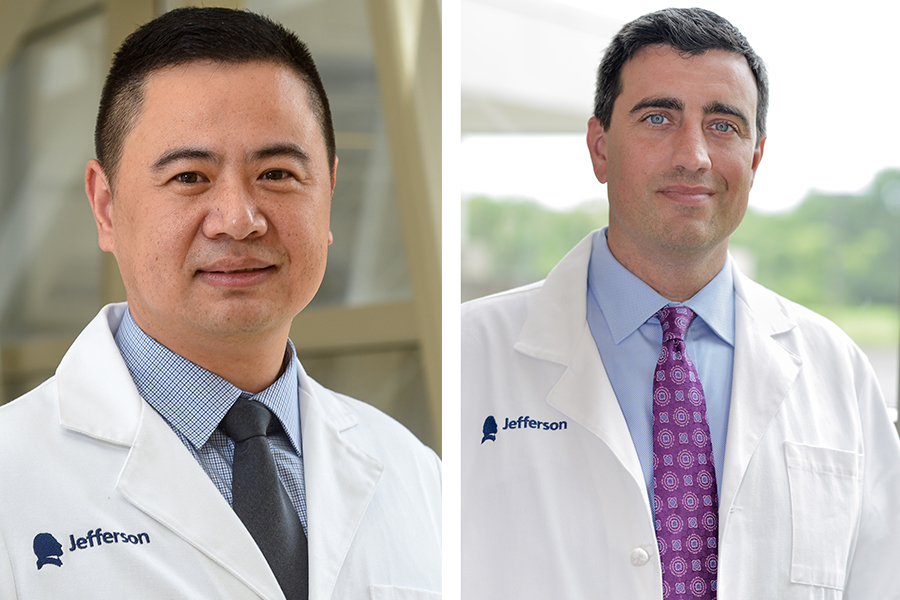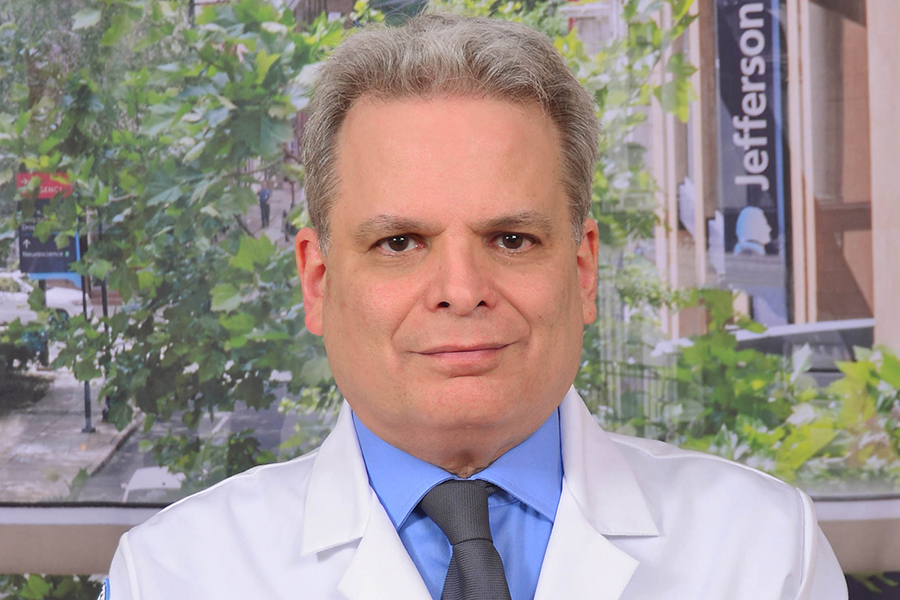When Faced with a Brain Tumor Diagnosis, There’s More Hope Than Ever–Thanks to the Work of These Local Physicians

The discovery of a tumor is often life changing. In that moment, when the patient is not just wondering about their prognosis, but the challenge of treatment and any possible side effects, they need a physician who can explain to them how, by combining the best tools they have at their disposal, they are going to give them the best possible result. That represents a significant challenge. Brain tumor treatment can be very complex and requires a highly individualized approach for all types of tumors.
That’s why physicians at Jefferson Health are employing new and innovative ways to effectively treat brain tumors by expanding their toolkit to include minimally invasive approaches and cutting-edge clinical trials. Physicians at Jefferson’s Vickie and Jack Farber Institute for Neuroscience, and the Sidney Kimmel Cancer Center (which recently was given the National Cancer Institute’s highest designation as a Comprehensive Cancer Center), are leading brain tumor treatment innovation in the region. They are giving hope to patients with the most advanced, personalized plans that are reshaping traditional brain tumor care.
“Many patients, when they seek out a surgeon, think that it really comes down to their surgical skill; however, what’s just as important is their judgment. And that judgment comes from experience, that judgment comes from expertise, that judgment comes from knowing as much as can possibly be known about the problem at hand and all the different ways we can treat it,” says Dr. Christopher Farrell, brain tumor neurosurgeon at Jefferson Health. “We have dedicated our entire careers to studying these brain tumors and finding the best treatments possible for our patients. Our program treats the highest volume of patients with brain tumors in our region and is one of the largest programs in the nation, and that expertise and experience is why our patients do so well.”
Through the application of advanced, creative technologies–from a clinical trial using tumor-treating electrical fields to the Gamma Knife–there is hope when faced with a brain tumor diagnosis. We spoke to the specialists at Jefferson Health who are reimagining what’s achievable in this complex, challenging field–and using that knowledge to change lives.

Getting to the Tumor
One of the greatest challenges in treating a brain tumor is its location. Even for benign tumors (tumors that are not cancerous), surgery is often necessary, but some types of surgeries can result in long recovery times for the patient. But that is changing now as more treatment options are available.
One notable solution incorporates a minimally invasive approach to access some brain tumors through the sinus cavities in the nose or mouth. This approach enables the neurosurgeons to access tumors that otherwise might have been difficult or impossible to reach, such as those at the base of the skull.
“We have this natural path directly to the tumor, and that makes it safer for the patient,” Dr. Farrell says. “And that means the recovery time is much shorter and the patient experiences less trauma, as we can work around the brain rather than going directly through the brain to reach the tumor.”
“Most of our patients who undergo brain surgery, even these incredibly complex surgeries, do remarkably well and are heading home in a couple of days. And I think that’s because of all the resources we have to take care of them afterwards at Jefferson Health,” Dr. Farrell says. “It can be an overwhelming diagnosis, but nothing eases patient anxieties more than belief in their treatment team. It’s so important to us to build a trusting relationship with our patients and their families.”

(Left) Dr. Wenyin Shi, radiation oncologist at Jefferson Health; (Right) Dr. Christopher Farrell, brain tumor neurosurgeon at Jefferson Health
Treatment at a Distance
Surgery is often the critical first step, but radiation can reach places that surgery cannot, and safely eliminate tumor cells close to healthy tissue. That’s where an innovative approach comes into play that can be transformative for the patient.
“Jefferson was one of the first institutions that brought radiosurgery to the patients in our region,” says Dr. Wenyin Shi, radiation oncologist at Jefferson Health.
Stereotactic radiation, also known as radiosurgery, uses the three-dimensional coordinates of a tumor to deliver radiation only to cancerous tissue, sparing healthy tissue from damage. At Jefferson Health, radiation oncologists develop a customized treatment plan to destroy the tumor, while minimizing treatment times and side effects.
As Dr. Shi explains, physicians at Jefferson are currently studying how artificial intelligence can help them maximize the effectiveness of these combinations of technologies while minimizing dosage and side effects. When the ideal ratio is achieved, the overall effect is minimum impact and side effects for the patient and maximum elimination of the tumor, all with a noninvasive treatment.
At Jefferson Health, physicians have pioneered the use of “frameless” Gamma Knife. “This innovative approach is much more comfortable for the patient,” explains Dr. Shi. “Traditional Gamma Knife requires an invasive procedure to stabilize the head during radiation, but with our frameless approach patients can receive an effective treatment with less discomfort and quicker recovery times.”
Jefferson is currently studying the use of electrical tumor-treating fields–a new type of treatment that uses electricity to damage cancer cells along with radiation treatment.
“By applying these two technologies together, they are actually synergistic,” Dr. Shi says.
The tumor-treating fields provide another non-invasive way to destroy cancer cells, but they can also interfere with the cellular processes that support cancer cell DNA damage repair. While radiation kills cancer cells by damaging their DNA, some cancer cells may recover. Tumor-treating fields prevent the cancer cell recovery, thus enhancing the effectiveness of radiation. Together, the hope is that the tumor is dismantled and remains that way, leading to less risk of recurrence and spread for the patient, as well as long-term survival.

Dr. Jon Glass, neuro-oncologist at Jefferson Health
Making the Body Work for You
Advancements in radiation therapy and brain surgery are enhancing treatments in challenging areas like the brain. At the same time, physicians at Jefferson Health are pioneering systemic therapies, including chemotherapy and immunotherapy. In the past, these therapies were often less effective for brain tumors, but they’re changing that.
“There’s a natural barrier between the blood and the brain that prevents a lot of treatments from actually getting into the nervous system,” says Dr. Jon Glass, neuro-oncologist at Jefferson Health. “As a result, many standard systemic treatments are ineffective.”
Oncologists are turning to other methods that harness the power of genetics, treatments known as targeted therapy, to attack tumors. For example, Jefferson has participated in clinical trials to study the effectiveness of IDH inhibitors, which, for certain types of brain tumors, can cut off the supply of a bodily chemical that allows them to grow. Another method is checkpoint therapy, which brings down the barriers that a tumor constructs to protect itself, making the tumor more vulnerable. Because these treatments use the unique genetics of the tumor to destroy cancer cells, they can reduce damage to the patient’s healthy tissue and resultant side effects.
Jefferson’s team of specialists are also looking to make immunotherapy more effective in brain tumor treatment, participating in a trial of a unique vaccine trial for glioblastoma, a type of brain cancer that is often fatal. This innovative treatment works by introducing glioblastoma cells from the patient’s own tumor into another part of the body–teaching the immune system to identify the unique nature of the tumor, similar to how a vaccine functions.
“Every tumor is a little bit different in terms of its genetic makeup,” Dr. Glass says. “So, this immunotherapy treatment should be better for an individual patient.”
The body can then identify the glioblastoma in the patient’s brain as dangerous–and allow white blood cells to cross the blood-brain barrier and help destroy the tumor.
“Our hope is that this clinical trial could extend the quality and length of life for patients with glioblastoma,” says Dr. Glass.
Because each patient’s case is unique, from brain tumor type and location, systemic treatment is often applied in combination with radiation and surgery. Even for patients with a diagnosis as challenging as glioblastoma, there is hope, as Jefferson physicians apply novel combinations of treatments, along with clinical trials, to achieve the best result possible.
“We’re constantly making progress in everything we do, from our understanding of the tumors at the genetic level to our development of new treatment options. Things are constantly moving forward, and all of these advances are helping our patients live longer and do better,” Dr. Farrell says. “It’s incredibly important for patients with brain tumors to have a great treatment team leading their care because this relationship will continue for many years, often for the rest of their life, as we continue to monitor the tumor.”
This is a paid partnership between Jefferson Health and Philadelphia Magazine

